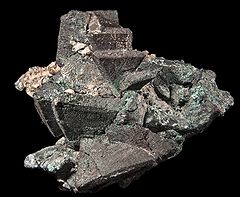Tennantite
| Tennantite | |
|---|---|

A sample of tennantite
|
|
| General | |
| Category | Sulfosalt minerals |
|
Formula (repeating unit) |
Cu6[Cu4(Fe,Zn)2]As4S13 |
| Strunz classification | 2.GB.05 |
| Crystal system | Cubic |
| Crystal class | Hextetrahedral (43m) H-M symbol: (4 3m) |
| Space group | I43m |
| Identification | |
| Color | Flint-gray to iron-black, cherry-red in transmitted light |
| Crystal habit | massive to well formed crystals |
| Twinning | Contact and penetration twins |
| Cleavage | None |
| Fracture | Subconchoidal to uneven |
| Tenacity | Somewhat brittle |
| Mohs scale hardness | 3 - 4.5 |
| Luster | Metallic, commonly splendent |
| Streak | reddish gray |
| Diaphaneity | Opaque, except in very thin fragments |
| Specific gravity | 4.65 |
| Polish luster | gray, inclining to black to brown to cherry-red |
| Optical properties | Isotropic |
| Refractive index | n greater than 2.72 |
| References | |
Tennantite is a copper arsenic sulfosalt mineral with an ideal formula Cu12As4S13. Due to variable substitution of the copper by iron and zinc the formula is Cu6[Cu4(Fe,Zn)2]As4S13. It is gray-black, steel-gray, iron-gray or black in color. A closely related mineral, tetrahedrite (Cu12Sb4S13) has antimony substituting for arsenic and the two form a solid solution series. The two have very similar properties and is often difficult to distinguish between tennantite and tetrahedrite. Iron, zinc, and silver substitute up to about 15% for the copper site.
The mineral was first described for an occurrence in Cornwall, England in 1819 and named after the English chemist Smithson Tennant (1761-1815).
It is found in hydrothermal veins and contact metamorphic deposits in association with other Cu–Pb–Zn–Ag sulfides and sulfosalts, pyrite, calcite, dolomite, siderite, barite, fluorite and quartz.
...
Wikipedia
